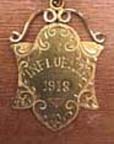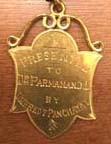|
|
 |
||||||||||||||||||||||||||
|
CHABLANI: - Diwan Sabaldas (Chhabaldas). Nukh: Khathoria ( web site: http://www.dalsabzi.com/Books/Sindhi_surnames/chapter%209.htm. I have added some information that I thought would be of interest.. Chablani having Khathoria as their Nukh migrated to Sind from Punjab. Some of them went to Shikarpur and others to Khudabad and then to Hyderabad. Some say that Ajwani, Bhavnani, Jagtiani, and Gidwani are cousins. But it is not so as their Nukh is Manchanda. Even Motwanis (Diwan Basantram and others) are Manchanda. The great grandfather of Chablani was Diwan Sabaldas (Chhabaldas) who, it is said was fond of all the good things in life. He loved to eat rich food. It is said that Diwan Chablani's family was very wealthy and well to do. They had a large herd of cattle that gave them abundant quantity of milk. The saying goes to say that after one of the daughters-in-laws washed her feet with milk their wealth decreased and Maya (Laxmi = Money) departed. There are two branches of Chablani. One branch lived alongside the Shivdasanis of Gosain Surajgar Ghitti and the other along side the Sipahimalanis. In 1947, the Chablanis of both the branches lived at Hirabad (Hyderabad) and at Karachi. The Chablani of Gosain Surajgar Ghitti and Shivdasanis had a common panchayat and a community hall. From the Gosain Surajgar Ghitti Chablanis came Diwan Bhorsingh. His sons: Diwan Hassomal and Diwan Chetanram. Both were Advocates. Diwan Hassomal was Mukhtiarkar (District Administrator) appointed by the Mirs. After the British takeover, the Mirs were to be deported to Calcutta and at their (Mirs) request Diwan Hassomal was permitted by the British to accompany them. In 1857, on his return journey from Calcutta, Diwan Hassomal was injured in a scuffle. From Diwan Hassomal’s family: Mr. Naraindas Ramchand Chablani MA and others. From the other branch of Chablani, Diwan Vishindas Mukhtiarkar. His two sons: Diwan Thawardas and Diwan Bulchand. Both were zamindars. Diwan Vishindas’ brother was Diwan Ghanshamdas. He also had two sons: Diwan Lalchand Mukhtiarkar and Diwan Kotumal Forester (Forest Officer). Diwan Lalchand Mukhtiarkar was a honest and God fearing man. He expired at Umer Kot. Amongst the Chablanis, the family of Mr. Parmanand Chetanram was also prominent. Those Chablanis who lived next to the Sipahmalanis, respected their customs and participated with them in all the functions, even though their Nukh was different i.e. Nagdev. Sipahmalanis considered them as member of the same Bradri. Prominent amongst the Chablani was Diwan Bahardinomal Majlasrai who had two sons Diwan Dayaram and Diwan Lekhraj. Diwan Lekhraj had four sons: M/s. Parmanand, Hashmatrai, Mangharam and Bulchand. Dr. Parmanand, a medical doctor, was connected with Hyderabad’s Civil and other Municipal Hospitals. In 1918 the Umer Kot panchayat recognized him for his voluntary medical services by presnting him with a gold medal. Dr.Parmanand’s wish was that his gold medal award be passed on to the next generations of medical practitionars in the Chablani family descendants, Dr.Janki Kini, his niece (daughter of his brother, Prof.Hasmatrai, was the first to wear the medal, this medal then transferred to Dr.Sharat Jain, the son of Janki’s sister, Roma Jain, and now in recent times is in possession of Dr.Nikhil Jain, son of Dr.Sharat Jain (UK) His successor is Dr.Sonia Dusseault, the grand-daughter of Janki Kini
Dr. Parmanand was married to Tillibai Gidwani, the surviving children from their marriage were Parpati, Satsaran and Popati. Dr. Parmanand's son Dr. Satsaran Chablani was in 1947, professor of Economics with D. J. Sind College at Karachi. After partition in 1946-47 he moved to New Delhi and joined the Indian Civil Service. In 1954 he was deputed as first secretary - commercial to the Embassy of India in Bonn, W. Germany. He was instrumental in organizing the development of iron and steel plants in Rourkela, India, in collaboration with major German iron and steel companies. Prof. Hashmatrai was born in 1889 and expired in the year 1934. Right from the young age he was brilliant student. While still in school, he received ‘Middle School Scholarship’. On reaching High School, he received ‘High School’ and ‘Sind Scholarships. Prof. Hashmatrai stood first in the University exams as well. He had chosen Physics, Chemistry, History, and Economics as his subjects. In the year 1911, after doing his BA, he did M.Sc. and again stood first in the University exam and won ‘Tilang Gold Medal’. Prof. Hashmatrai was a professor at B. B. College in Bihar, D. A. V. College Lahore, Jaswant College Jodhpur, and Benaras Hindu University and at Elphinstone College Bombay. He was Principal of Hyderabad’s Dayaram Gidumal National College as well. Later, Professor Hashmatrai was appointed head of Delhi University’s Economics Department. In 1929, Professor Hashmatrai became member of Govt. of India’s ‘Banking Inquiry Committee'. An issue arose to separate the province of Sind from Bombay Presidency. Professor Hashmatrai opposed the proposal. He, Professor Hashmatrai was a very good narrator and fluent in English and Sindhi. He awakened the Hindus and brought to their notice that though the Hindus were in minority in Sind, yet they contributed a major portion in taxes to Sind’s exchequer. If Sind separated, contribution for the shortfall from Bombay’s exchequer would stop and the same would have to be borne by the Hindus as they being the trading community, would have to be the sole contributors. He vigorously pleaded against the separation. Professor Hashmatrai published a book in English giving facts and figures showing the amount of money Bombay Presidency had contributed to meet Sind’s shortfall since 1847. The figures awakened the Governments at Bombay and Delhi. With the publication of his book, Prof. Chablani became famous overnight throughout India. A round table conference was to be held at London, and Prof.Hashmatrai Chablani was deputed by the British Indian Govt. to express his views to UK Parlament. It was at this conference that decision took place to separate Sind from Bombay effective 1936 with the understanding that any shortfall in Sind’s budget would be met by the central Govt. of India Delhi. Prof. Hashmatrai Chablani wrote several books concerning the currency, banking and internal problems of India. He also wrote on ‘History of England’ in two volumes. Diwan Bherumal M. Advani, the author, had translated the same into Sindhi and in 1947 they were textbooks in the schools. Prof. Hashmatrai Chablani was responsible for the creation of Karachi’s Model High School and a Municipal School that was named after him. Khudabadi Amil Panchayat’s Hospital on Karachi’s Bunder Road was also named after him. Mr. Mangharam Chablani was born in 1896. He passed his BA in 1917 and taught at Govt. owned S. T. C. D. College at Bombay. In 1921 he received First Class Diploma. After passing his B.A., he joined the Education Dept. While teaching at Karachi’s Govt. High School, Mr. Mangharam passed his M.A. In 1926, with the help of his brother Prof. Hashmatrai, he established Karachi’s Model High School and was its Principal. In 1936, Mr. Mangharam inaugurated Wadhumal Bulchand High School at Karachi on Bunder Road Extension. The following year he added a primary School to it. In 1947, Mr. Chandiram Bulchand Advani was its Principal. After partition in 1947, Mr. Mangharam Chablani and family moved to Bombay and settled there with his wife Lachmi, and two sons Mohan and Narain. Some years later, for reasons not known Mr. Mangharam and wife, moved to a place in Kutch most likely to participate in the new developments in the area which were of interest to the Sindi community Mr. Mangharam was President of Head Masters Association at Karachi and Vice President of Karachi’s Boy Scout Association. In 1947, he was Secretary of Indian Girls High School Karachi. He was Hon. Secretary of Karachi’s Education Advancement Society and of Female Education Society. Mr. Mangharam was in 1947, treasurer and member of the managing committee of Karachi’s Hyderabad Amil Panchayat, and had written many books. Mr. Hassaram Parmanand Chablani, the retired Engineer, was in fact a Mirchandani, but had changed his surname to Chablani. He was grandson of Munshi Adomal Mirchandani.
|
||||||||||||||||||||||||||
|
This site designed and maintained by Sindhi volunteers at Tarola International / USA - Site Hosted by Tarola.Net |
||||||||||||||||||||||||||

